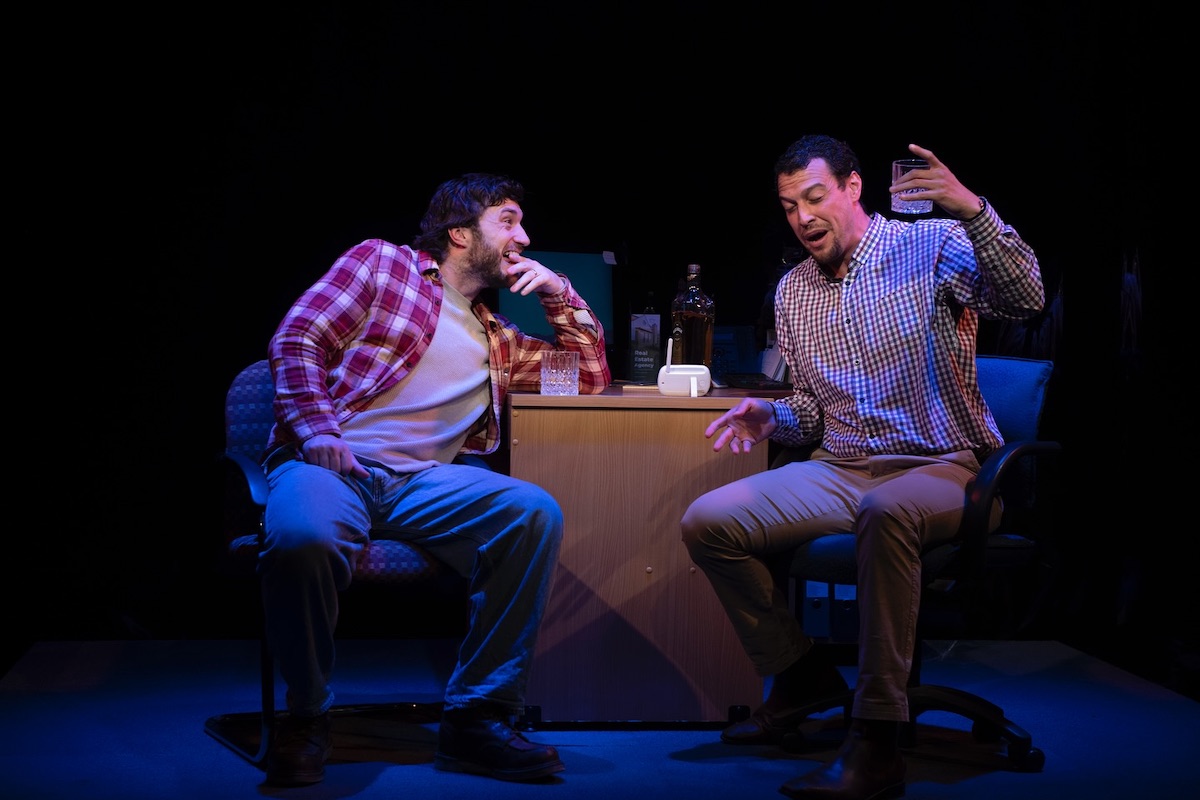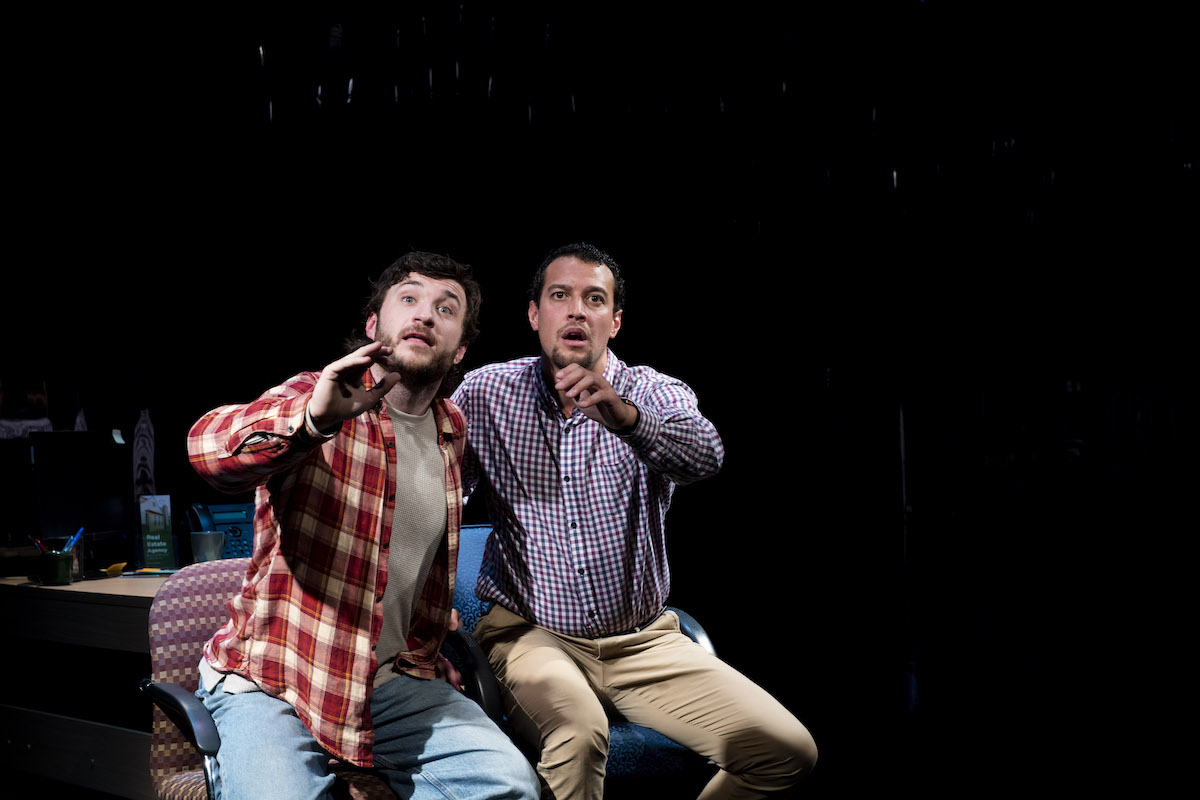It’s not a spoiler to say that by the end of Red Stitch’s arresting new staging of Samuel D. Hunter’s A Case for the Existence of God, there is a pamphlet for a mortgage broker floating in pitch black water onstage. It’s the perfect symbol for the play, which often finds near-divine (though never explicitly religious) meaning in the everyday, seemingly banal things that make a life.
We begin the show in the middle of what is perhaps the most banal thing: a meeting with a mortgage broker. The recently divorced, blue-collar Ryan (Darcy Kent) is trying to secure a loan for a 12-acre piece of land that once belonged to his family on the outskirts of the small town of Twin Falls, Idaho.
The land is not for him, really, but for his 15-month old daughter; an attempt to give her the life he believes she deserves. It’s this dedication to parenting that he shares with his broker, the ever-cheerful foster-care parent Keith (Kevin Hofbauer), and which brings the unlikely pair together over the course of the 75-minute two-hander.

Darcy Kent and Kevin Hofbauer in Red Stitch Actors’ Theatre’s A Case for the Existence of God. Photo © Jodie Hutchinson
This imperfect, but ambitious production directed by Gary Abrahams represents the second staging of Hunter’s play this week. The first, from Outhouse Theatre Co, premiered just two days ago in Sydney. Clearly, there’s something about the play that’s connecting. Hunter became a household name recently with the Oscar-winning film adaptation of his play The Whale, so maybe it’s just coincidental. But, as this newest production shows, mere coincidence can have a divine import.
It was coincidental, after all, that Keith and Ryan chose the same daycare for their daughters, and that they went to the same high school. On paper, the pair share more differences than similarities: Ryan, the down-to-earth hetero factory worker; quick to anger, but with a heart of gold; Keith, the queer black man, a lover of Early Music and loan legalities. They share one important thing: they’re both single Dads anxious to prove themselves.
Hofbauer has an ease and warmth about him as the music-loving mortgage broking Keith; chipper and earnest with a wide smile and even wider eyes. However, as the show continues, his character can feel somewhat stuck in one mode of rote Midwest earnestness, as if Hofbauer never quite sheds the performative air of a broker trying to make a sale.
It’s a problem highlighted by Kent, whose performance feels contrastingly lived-in from the outset. His Ryan is a himbo with a fragile hold on a live-wire temper; all burly Pacific Northwest drawl (dialect coach, Matt Furlani has done an incredible job) and good intentions. He becomes more real as the show continues, landing the show’s increasing tragedies with a gut-wrenching believability. Hofbauer, too, shines when he strips back all affectation during a simple, tearful monologue about his daughter.

Darcy Kent and Kevin Hofbauer in Red Stitch Actors’ Theatre’s A Case for the Existence of God. Photo © Jodie Hutchinson
It’s a one-set show, and, without spoiling too much, this production has chosen an ingenious way to make sure it doesn’t feel stagnant. Where previous productions have shrouded the Ryan and Keith in dark shadow, here that shadow is made literal with towering black vinyl curtains that surround them. It’s a bold staging choice, the near-dystopian vibe of Beckett via Under the Skin or Twin Peaks; a surrealist framing device that makes it appear as if the two friends exist in an abyss, hurtling through space.
It’s evocative, but it does seem jarringly artificial in a show so interested in the natural world; more a Gothic hellscape than the stripped-back mundanity that is Hunter’s bread-and-butter.
Then, there is the problem that the material dulls Sidney Younger’s lighting design, which fights to light more than a few centimetres on the jet black. Conceptually, there is a resonance to the effect – a representation of the pairs dwindling hopes?
But more might have been made of the distorting effect that comes when the light is cast on the sheer black. As it stands, much of Sidney’s larger design flourishes are swallowed and lost before we can really appreciate them.
Overall there is a tension between design choices that favour a more clinical detachment – cold black vinyls, the jarring sound of static to create scene transitions – and the warmth of these characters and the script that isn’t quite resolved. Ryan and Keith’s salt-of-the-earth ways and the script’s often heart-warming (and heart-wrenching) sentimentality can be at odds with these impersonal choices.
But Abrahams has often been drawn to minimalistic and macabre aesthetic styles, from the Gothic-folk of Yentl to this pitch-black production, and there are moments of transcendence here when other design elements (which I won’t spoil) create a graveyard of everyday objects that surround Ryan and Keith, stripping back the set entirely to spotlight the pair’s connection to each other.
This is perhaps one of Hunter’s most hopeful plays and it ends with a particularly sentimental coda that transcends time just to tie up loose ends. Rather than leave us floating adrift in some hopeless black abyss, Hunter wants us to feel grounded by a friendship between two new Dads who are connected because of, rather than despite, their differences. Their friendship might not transcend the everyday, but it does feel hopeful in a way that seems, if not holy, at least a little sublime.
A Case for the Existence of God plays at Red Stitch Actors’ Theatre, Melbourne, until 12 May.











Comments
Log in to join the conversation.